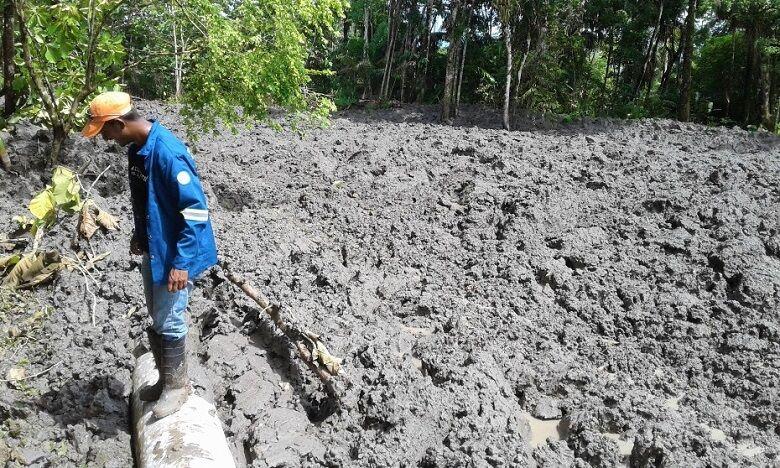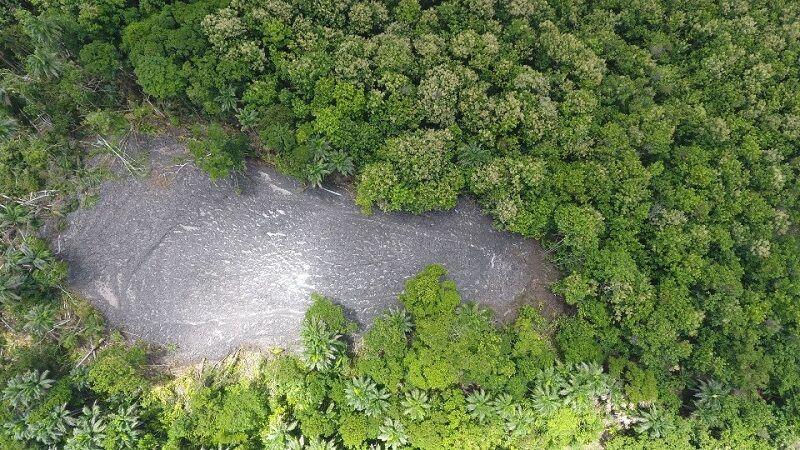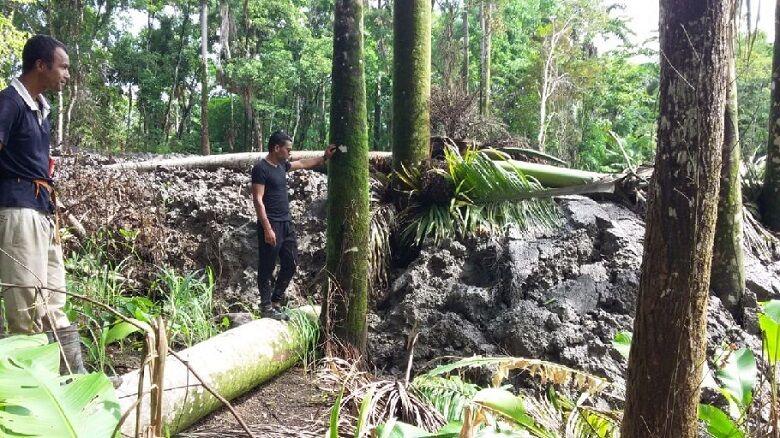|
lake of mud: An aerial view of the mud volcano that erupted at Brickfield Village, Tabaquite, in July 2019. @Caption:—Photo courtesy Xavier Moonan, senior geoscientist at Touchstone Exploration. NEAR the village of Brickfield, in Trinidad’s interior, there is a woman who walks the main road most days, talking to herself, and to anyone who has time to spare. One morning in July 2019, she stopped at a roadside carat shed outside the Agriculture Ministry’s Forestry Division office and told an incredulous story to the workers. It was about what she had heard coming from deep in the bush while walking along a lonely stretch of the Tabaquite Main Road the week before. There was an explosion in the forest, she told them, and a sound like thunder, and then the crackling of falling trees. Birds flew from the direction of the sound, she said. Then there was silence. The forest workers suspected they knew what was the source of the disturbance. So the gang of seven, whose job it is maintain vast acreages of teak in a part of Trinidad desperate for development, went in search. Trees snapped like twigs: The force of the mud volcano against the trees. With chainsaws and cutlasses, they cut a path into the woods off Colonzo Trace, and walked more than a kilometre before abandoning the effort. All they found was deepening bush, and too many snakes, according to Forestry worker Suresh Roopnarine. But there was still some daylight left, and curiosity got the better of them. So they decided to clear an old timber access road, and chopped a path for about two kilometres before coming upon what the woman had heard. A mud volcano had erupted to life, tearing down the forest trees, and clearing an area of at least two acres. In the midst of greenery, they found a roiling lake of mud and severed trees. And it continues to throw up new deposits, slowly expanding outward, the Express noted during a visit days later. Surreal sight There were no houses nearby. The nearest resident, living about three kilometres from the site, said he had no idea it had happened, and had no plan to visit “a big hole in the ground”. The damage done was to the forest trees, many pushed over by the mud flow, others snapped like twigs. It is a surreal sight. A lake of mud surrounded by a wall of trees, in the shape of a footprint. The new mud volcano is located about eight kilometres east of the Piparo mud volcano, which erupted in February 1997, burying the roadway, homes and vehicles. And the last time there was an eruption of this magnitude was February 2018 when the dormant Devil’s Woodyard mud volcano belched to life and disgorged mud 100 metres wide and 1.8 metres deep. Senior geoscientist at Touchstone Exploration Xavier Moonan and members of the Geological Society of Trinidad and Tobago Keston Brown and Stefon Harrypersad trekked into the forest and conducted an initial study. Said Moonan then: “The flow is fairly recent... we can’t estimate exactly when. The leaves of the trees that fell due to the mud flow are still green, but we were advised by experienced foresters that these particular trees can remain with green leaves even after they have been felled for months. The mud itself hasn’t been weathered much, and the flow structures are still very distinct, so I would estimate it happened in the last couple weeks at maximum.” He said from the historical data and satellite imagery, it appears that the July eruption was the first large-scale one since at least 1940.  Expanding outwards: The mud volcano that erupted in Brickfield Village Moonan’s information was corroborated by village elders who recall visiting the site decades ago and seeing multiple conical vents in the forest before the woods became impenetrable and the site passed into memory. Call it Polly Maharaj
So, what caused the eruption? Faults are breaks in the rocks and can extend to significant depths in the earth. The Brickfield mud volcano is located on what geologists know as the Tabaquite fault. At depths below the Tabaquite area, there are sands with oil, gas and salt water trapped by clays. The movement on the fault allows the trap to break for an instant, allowing the water, oil and gas to escape, said Moonan, who is also vice-president of the American Association of Petroleum Geologists Latin America and Caribbean region. The fluids travel upwards to the surface where they pick up bits of rock—clay, sandstone and limestone along the way, and this is the mud flow that we see when it explodes at the surface. And although the Piparo mud volcano is nearby, it is not related to the Brickfield mud volcano since they occur on separate faults, said Moonan. Regarding the size of the eruption, Moonan said the mud flow covers an area similar to the size at Devil’s Woodyard. The team measured the maximum length of mud flow at 165 metres (a football field is 110 metres in length) and the maximum width at 76 metres. The geologists said the mud flow was expelled in a north-westerly direction along a three-degree gradient slope, with the flow turning to the north at approximately 33 metres downslope. And the estimated volume of mud expelled? It’s 1,740 cubic metres or approximately 11,000 barrels. The mud flow is much less thick than that which was observed at the Devil’s Woodyard eruption, hence the volume is significantly less. Despite this, the force of the eruption was just as damaging, felling lots of trees in its path. And for adventurers interested in seeing this natural phenomenon, there is a warning, It’s not near a road, so be prepared to hike along a forest trail, on State lands. And there will be snakes. Do not go alone. Do not go at night. Walk with water. Wear the right footwear. It’s going to be muddy. And you can call it Polly Maharaj. That’s the name of the woman who discovered it. (Source: Daily Express, July 13, 2022)
0 Comments
Leave a Reply. |
T&T news blogThe intent of this blog is to bring some news from home and other fun items. If you enjoy what you read, please leave us a comment.. Archives
May 2025
Categories
All
|



 RSS Feed
RSS Feed